Smart Home Automation Devices That Simplify Life. Not long ago, walking into a house that responded to your voice, adjusted lighting based on your mood, and brewed coffee before you even got out of bed felt like a sci-fi dream. Today, it’s an everyday reality. With the rise of automation tools, homes are becoming more intuitive, energy-conscious, and accessible.
But there is a challenge. Nowadays, there are many smart home devices on the market. Each one promises more comfort and efficiency. However, it is easy to feel overwhelmed. So, should you invest in a smart thermostat to control your climate, or start with a security system to keep your home safe? Alternatively, do you really need a hub to connect everything, or can your smartphone and voice assistant manage it on their own? In the end, this guide will help you make the right choice and buy smart, not blind.
This guide removes the guesswork. Together, we’ll explore:
- The most popular automation technologies for different areas of your home.
- How these solutions improve convenience, efficiency, and security.
- Common challenges to watch out for before investing.
- A closer look at the best brands dominating 2025.
- Predictions on where the future of connected living is headed.
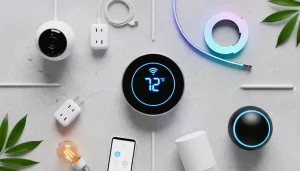
If you’re brand new to the concept, I also recommend checking my guide on the best smart home devices for beginners.
Why Smart Home Automation Devices Matter
Imagine this scenario: you arrive home after a draining day. As soon as you unlock the door, the hallway lights brighten softly, your favorite playlist begins in the background, and the living room is already at your ideal temperature. You didn’t press a button. You didn’t speak a command. Your home simply knew.

This is the real value of automation. Yes, it’s convenient, but it’s also transformative in ways that impact lifestyle, savings, and peace of mind.
Key Benefits of Smart Home Automation
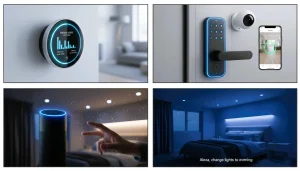
-
Save Energy Effortlessly with Smart Home Automation Devices
- Climate control systems can reduce heating and cooling bills by up to 20–30% when programmed effectively.
- Adaptive lighting ensures bulbs are never left on unnecessarily.
-
Protect Your Home with Smart Security Automation Tools
- Locks, motion sensors, and surveillance keep intruders out and provide remote monitoring.
- Environmental sensors detect smoke, gas leaks, or flooding before they escalate.
-
Enhance Accessibility and Comfort with Smart Home Technology
- Voice assistants empower older people or individuals with limited mobility to control their environments hands-free.
- Automated reminders can aid those with memory challenges.
-
Increase Your Property Value Using Smart Home Automation Devices
- Homes equipped with advanced automation tools often sell faster and at higher prices because buyers recognize the long-term savings and lifestyle upgrades.
Curious about how this connects to energy savings? Read my full breakdown of smart thermostats and energy efficiency.
Categories of Smart Home Automation in 2025
Let’s break down the most impactful types of automation, room by room and function by function.
-
Smart Lighting Devices for Modern Homes
Lighting is often the first step into automation because it’s affordable, easy to install, and instantly noticeable.
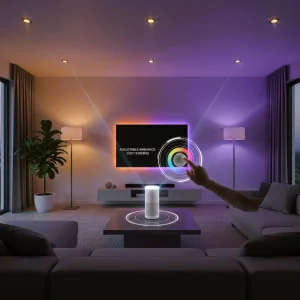
Benefits include:
- Schedule lights to simulate occupancy while you’re away.
- Control dimming, color, and ambiance through your phone or by voice.
- Reduce energy waste by automatically switching off unused fixtures.
Leading Names in 2025:
- Philips Hue – unmatched ecosystem with bulbs, light strips, and outdoor options.
- Nanoleaf – known for artistic, customizable wall panels.
- LIFX – delivers bright, Wi-Fi–enabled bulbs without needing a hub.
If you’re torn between ecosystems, read my Smart Lighting Brand Comparison for practical insights.
-
Energy-Saving Climate Control Systems
Heating and cooling account for nearly half of your home’s energy costs. That is why smart climate controllers can make a real difference. By using the right device, you can cut bills, improve comfort, and take control of your energy use with just a few taps.
Key Features:
- Learn daily habits and adjust automatically.
- Provide energy consumption reports.
- Pair with sensors in multiple rooms for zoned comfort.
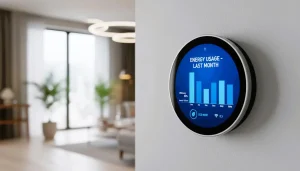
Top Picks in 2025:
- Ecobee Premium – praised for advanced AI-driven scheduling.
- Nest Learning Thermostat – sleek design and predictive learning.
- Honeywell Home T9 – affordable and reliable with room sensors.
Want specifics? I recently published a full Ecobee Smart Thermostat Premium Review.
-
Smart Security and Monitoring Devices
Security remains one of the biggest reasons homeowners invest in smart technology. The peace of mind you gain from knowing your property is protected around the clock is truly invaluable. With the right smart security system, you can monitor, manage, and secure your home—no matter where you are.

Devices worth considering:
- Smart locks – eliminate physical keys and allow temporary access codes.
- Video doorbells – offer live monitoring, visitor detection, and two-way communication.
- Indoor/outdoor cameras – now powered with AI motion detection to reduce false alarms.
- Safety sensors – detect smoke, carbon monoxide, and water leaks.
Notable Brands:
- Ring (doorbells, cameras).
- Arlo (wireless cameras with excellent resolution).
- Eufy (budget-friendly but high-performing).
- SimpliSafe (complete DIY-friendly systems).
Explore my full Best Home Security Systems Guide for detailed comparisons.
-
Voice Assistants and Smart Speakers
Think of them as the central nervous system of an automated home. From setting reminders to orchestrating multiple routines, these assistants bridge convenience with functionality.
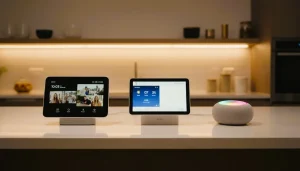
Top Options:
- Amazon Echo Show – combines Alexa with a touch display.
- Google Nest Hub – great for Google ecosystem fans.
- Apple HomePod Mini – compact, privacy-focused, and ideal for Apple households.
Still unsure? See my breakdown of Alexa vs Google Assistant vs Siri.
-
Connected Appliances That Simplify Life
Appliances are evolving faster than ever. Kitchens and laundry rooms are becoming the epicenter of innovation.
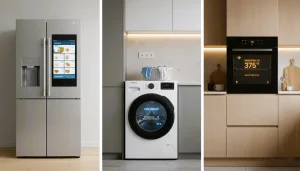
Highlights in 2025:
- Refrigerators that inventory contents and suggest recipes.
- Washing machines that notify you via app when loads are complete.
- Ovens that preheat remotely and monitor internal temperatures with precision.
Examples to Watch:
- Samsung Family Hub Refrigerator.
- LG ThinQ Washers.
- GE Profile Smart Ovens.
Check out my roundup: Top Smart Kitchen Devices That Save Time and Energy.
-
Smart Hubs to Control Every Device
For households juggling multiple automation solutions, hubs act as unifying bridges.
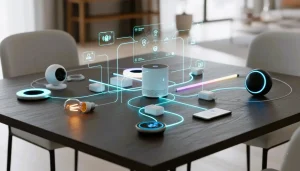
Noteworthy Choices:
- Samsung SmartThings.
- Amazon Echo Hub.
- Matter-compatible hubs that ensure cross-platform compatibility.
I wrote a dedicated piece on Matter-Compatible Smart Hubs that you may find useful.
Real-Life Applications of Smart Homes
To make this less abstract, let’s look at real-world scenarios:

-
Smart Home Tips for Frequent Travelers
- Uses lighting automation to deter burglars.
- Monitors the doorbell camera while abroad.
- Adjusts heating remotely to avoid wasted energy.
-
Home Automation for Busy Parents
- Relies on voice assistants to manage schedules.
- Uses smart cameras to check on kids or pets.
- Automates bedtime routines with dimming lights and white noise.
-
Energy-Saving Tools for Smart Homes
- Tracks consumption data via thermostat reports.
- Schedules appliances to run during off-peak hours.
- Uses solar-compatible solutions integrated with storage batteries.
Benefits Recap of Smart Home Automation Devices
To summarize the core advantages:
- Seamless control from apps or voice commands.
- Noticeable energy savings.
- Round-the-clock safety monitoring.
- Personalized routines.
- Inclusive design for people with different needs.

My separate article on How Smart Homes Save Energy includes case studies with real numbers.
Challenges and Considerations
Before investing, be mindful of:

- Compatibility issues – not every system works across platforms.
- Privacy and security – data breaches are a legitimate concern.
- Cost – the initial outlay can be significant.
- Connectivity reliance – a weak Wi-Fi network undermines everything.
For details, see my piece: Risks of Smart Home Technology.
How to Choose the Right Smart Home Automation Devices
Here’s my step-by-step buying framework:
- Define your priorities – security, comfort, or energy efficiency?
- Start small – one or two solutions help you learn without overwhelm.
- Check ecosystem compatibility – decide whether you prefer Amazon, Google, or Apple integration.
- Think long-term – ensure the tech you buy can scale with your needs.
- Research reviews – prioritize reliability and strong customer support.

Still deciding? My Starter Bundles Guide breaks down cost-effective options for beginners.
Trusted Brands in 2025
The leaders shaping automation today include:
- Amazon (Echo, Ring, Blink).
- Google (Nest ecosystem).
- Apple (HomeKit, HomePod mini).
- Samsung (SmartThings, Family Hub).
- Philips Hue (lighting).
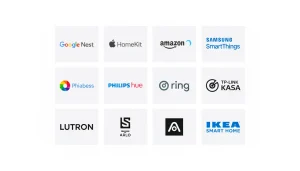
For lighting enthusiasts, don’t miss my Philips Hue Detailed Review.
The Future of Home Automation
What lies ahead?
- AI-driven personalization – homes that anticipate your needs.
- Matter adoption – eliminating ecosystem silos.
- Eco-conscious design – solar-integrated and recyclable gadgets.
- Home robotics – cleaning, companionship, and caregiving bots.
- Health integration – homes that track sleep, air quality, and overall wellness.

For more, see my analysis: The Role of AI in Next-Gen Smart Homes.
Frequently Asked Questions (FAQs)

-
What is the first smart home device I should buy?
Most people start with smart lighting or a thermostat because they’re affordable, easy to set up, and instantly useful. If security is your top priority, a video doorbell or smart lock is also a great starting point.
-
Do I need a smart home hub?
Not always. Many gadgets connect directly to your Wi-Fi or smartphone. However, if you want multiple devices to work together smoothly, a hub (such as Samsung SmartThings or Amazon Echo Hub) or a Matter-compatible controller makes life much easier.
-
Will these devices work without Wi-Fi?
Some features, like local Bluetooth control, may still work. But most automation tools rely heavily on Wi-Fi for remote access, voice control, and app functionality. A strong, reliable internet connection is essential for the best experience.
- Are smart home devices secure?
Yes—if you take precautions. Always:
- Use strong, unique passwords.
- Enable two-factor authentication where possible.
- Keep firmware updated.
- Buy from trusted brands with strong privacy policies.
For more, check my guide on smart home security risks.
-
Do smart devices save money on bills?
Absolutely. Smart thermostats, lighting, and energy monitors help reduce unnecessary usage. Over time, many households see 10–30% lower energy bills.
-
Can I use smart devices if I rent my home?
Yes. Portable and wireless options like smart plugs, bulbs, and voice assistants are landlord-friendly because they don’t require rewiring or permanent installation.
-
Which voice assistant is the best?
It depends on your ecosystem:
- Amazon Alexa works with the widest range of products.
- Google Assistant excels in natural voice recognition and Google services.
- Apple Siri offers tight integration with iOS and strong privacy features.
-
Do smart appliances really make a difference?
Yes. Smart ovens, washers, and refrigerators give alerts, remote control, and energy tips. They are not essential, but very convenient once you start using them.
-
What’s the difference between smart plugs and smart power strips?
- Smart plugs control one appliance at a time.
- Smart power strips allow control over multiple outlets—great for entertainment systems or office setups.
-
What’s next for smart homes?
The future is moving toward:
- AI-driven personalization (anticipating needs before you ask).
- Health monitoring integration (tracking air quality, sleep, wellness).
- Eco-friendly designs (solar-powered, recyclable tech).
- Robotics (cleaning bots, caregiving companions).
Conclusion
Home automation is no longer a luxury—it’s a practical lifestyle upgrade. Whether you’re dipping your toes with a single light bulb or creating a fully connected ecosystem, the key is intentionality. Choose technology that aligns with your goals, integrates smoothly, and grows with you.
By 2025, connected living is about more than gadgets; it’s about creating homes that save energy, protect families, and adapt seamlessly to modern life.

Ready for the next step? Don’t miss my guide to the Best Home Automation Devices in 2025.
